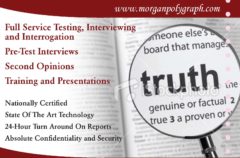
It’s crucial for you to understand the reliable methods employed by polygraph examiners to assess truthfulness during evaluations. These skilled professionals utilize various techniques, including physiological measurements, behavioral analysis, and the establishment of baseline responses, to detect potential deception. By examining changes in heart rate, blood pressure, and respiratory patterns, you can gain insight into how these indicators may reveal underlying emotions when faced with specific questions. In this post, we’ll investigate into the specific strategies and technologies that polygraph examiners leverage to help you better grasp the complexities of lie detection.
The Science Behind Polygraph Testing
A polygraph exam combines various scientific principles to measure physiological responses that may indicate deception. By monitoring changes in your body, such as heart rate, blood pressure, respiration, and skin conductivity, examiners evaluate your emotional state during questioning. It’s important to understand that these responses can be influenced by numerous factors, which complicates the interpretation of the results.
Physiological Responses
To measure your physiological responses accurately, polygraph examiners utilize sensors attached to your body. These devices track fluctuations in your heart rate, blood pressure, and sweating, among other indicators. When you respond to questions, the changes in these metrics can signal levels of stress or anxiety often associated with deception.
Psychological Factors
One important aspect of polygraph testing involves the psychological factors at play. Your mental state, including anxiety or fear about the consequences of lying, can impact physiological responses. Examiners understand that various emotional triggers can affect how you react during the test. Factors to consider include:
- Your familiarity with the questions
- The level of stress you might be experiencing
- Your individual baseline physiological responses
- Your ability to manage anxiety during the test
Perceiving these psychological aspects allows examiners to differentiate between genuine reactions to stress and those caused by deception.
It’s crucial to note that psychological factors can significantly influence the reliability of polygraph tests. The state of your mind, whether you are anxious, confident, or nervous, plays a vital role in how you physically respond. Key considerations include:
- Your prior experiences with polygraphs
- Your perception of the examiner’s authority
- Your belief in the accuracy of the test
- Your emotional state leading up to the exam
Perceiving these psychological undercurrents can help explain why someone might appear deceptive even when they are telling the truth.
Key Techniques Used by Polygraph Examiners
Clearly, polygraph examiners employ various techniques to effectively identify deception. Among these are establishing baselines and utilizing sophisticated questioning methods, tailored to gauge your physiological responses. Understanding these techniques can help you appreciate the intricate process behind polygraph examinations.
Establishing a Baseline
With establishing a baseline, polygraph examiners first measure your normal physiological responses to neutral questions. This sets a reference point for comparison during the actual questioning phase. By understanding your baseline reactions, examiners can identify deviations that may indicate stress or dishonesty when more probing questions are asked.
Questioning Techniques
Any effective polygraph examination hinges on the questioning techniques employed by the examiner. They carefully design questions to provoke measurable physiological responses, ensuring they capture your reactions accurately. This includes both control questions and relevant questions pertaining to the specific inquiry, allowing for a clear analysis of your truthfulness.
Questioning techniques are strategically structured to elicit truthful responses while observing your physiological changes. Examiners often employ control questions which relate to common experiences and serve as a baseline for your normal responses. When they introduce relevant questions about specific incidents, the differences in your physiological reactions can illuminate potential deception. This methodical approach allows examiners to differentiate between truthful and deceptive responses effectively.

Analyzing Physiological Data
You might be surprised to learn that polygraph examiners analyze various physiological data to assess the truthfulness of a subject. Monitoring changes in heart rate, blood pressure, and skin response allows examiners to gather insights into your emotional state during questioning. When these physiological metrics vary unexpectedly, they may indicate stress or deception, providing valuable information that can influence the examiner’s conclusions.
Heart Rate and Blood Pressure
Data collected from your heart rate and blood pressure can reveal your body’s response to stress and anxiety. When you respond to questions, any significant deviations from your normal baseline can signal distress, prompting further investigation. Polygraph examiners closely monitor these metrics for signs that might indicate you are not being truthful.
Galvanic Skin Response
For polygraph examiners, galvanic skin response plays a key role in assessing your truthfulness. This measurement captures the electrical conductivity of your skin, which can fluctuate based on sweat gland activity. When you experience emotional arousal, such as nervousness or fear, your body tends to sweat more, leading to an increase in electrical conductivity. This physiological reaction is often a telltale sign of stress and can indicate that you may be concealing the truth.
Due to the intimate connection between emotional responses and physiological changes, the galvanic skin response serves as a valuable tool in lie detection. Examiners analyze fluctuations in this response during questioning, looking for patterns that may suggest deceit. An elevated response might indicate anxiety tied to the subject matter of the questions, further supporting the analysis of other physiological data points to draw a comprehensive conclusion about your honesty.
Behavioral Cues During the Test
Keep in mind that polygraph examiners are highly skilled at observing various behavioral cues during the test. These cues can provide insight into your truthfulness. They focus on both verbal and nonverbal signals, which can indicate whether you are being deceptive or honest. Understanding these cues can help you prepare and respond more effectively during the examination process.
Nonverbal Communication
Along with verbal responses, nonverbal communication plays a significant role in your polygraph examination. Body language such as posture, eye contact, and facial expressions can reveal inconsistencies in your statements. By being aware of your nonverbal cues, you can present a more authentic demeanor throughout the test.
Verbal Indicators
Any inconsistency in your verbal responses can raise red flags during the polygraph examination. Examiners may look for signs of nervousness, hesitation, or contradictions in your narrative. These verbal indicators can provide clues about your honesty, which is why it’s important to be clear and consistent when answering questions.
Verbal cues can consist of various elements such as speech patterns, tone, and clarity. For instance, speaking too quickly might signal anxiety, while long pauses may indicate that you are fabricating information. Examiners pay close attention to these factors, as contradictions or inconsistencies in your answers can suggest that you may not be telling the truth. Ensuring that your verbal communication aligns with your intended message is vital to demonstrating your honesty during the examination.

Common Misconceptions About Polygraph Tests
Once again, many people have misconceptions about how polygraph tests work and their efficacy. Some believe that polygraphs can unequivocally determine whether someone is lying, while others think that polygraphs can be easily fooled. In reality, polygraph examinations measure physiological responses that may indicate stress or deception, but they are not foolproof. Your understanding of how these tests function will help you navigate discussions around their validity and use in various contexts.
Accuracy and Reliability
Any discussion of polygraph tests inevitably leads to debates about their accuracy and reliability. While some studies report varying success rates, it is necessary to recognize that no test is 100% accurate. Your interpretation and acceptance of polygraph results should involve a comprehensive understanding of these limitations, along with the context in which the test is administered.
Legal Implications
Above all, the legal implications of polygraph testing can be significant. Many jurisdictions have strict regulations regarding the admissibility of polygraph results in court, leading to varying acceptance based on location and case specifics. Your knowledge of these legal parameters is vital, especially if you are involved in legal processes where polygraphs may be used as evidence.
But the landscape of polygraph testing is nuanced. Many legal systems view polygraph results as inadmissible because of their subjective nature and the potential for error. Additionally, in certain contexts, individuals may be coerced into taking a polygraph, raising ethical concerns about informed consent. Understanding these implications can help you approach the topic with greater awareness and discernment.
Practical Applications of Polygraph Testing
Your understanding of polygraph testing extends beyond theoretical knowledge; it plays a vital role in various fields. Polygraphs are increasingly utilized to enhance security measures, investigate crimes, and verify employee integrity. By assessing physiological responses, these tests give key insights that can guide decision-making in sensitive situations. As you investigate deeper, you’ll discover how different sectors leverage this technology for effective outcomes.
Law Enforcement
Around the world, law enforcement agencies employ polygraph testing as a supplementary tool in criminal investigations. These tests help establish the credibility of witnesses or suspects by measuring physiological reactions to specific questions. By providing an additional layer of scrutiny, polygraphs can assist in uncovering hidden truths that may not be apparent through traditional investigative methods.
Corporate Investigations
Corporate settings increasingly adopt polygraph testing to maintain a safe and trustworthy work environment. You might find that this technique helps deter misconduct and ensures regulatory compliance, especially in industries dealing with sensitive information or financial transactions. Employers often rely on polygraph tests during pre-employment screenings or internal investigations to protect their assets and mitigate risks associated with dishonest behavior.
In addition, many companies utilize polygraphs to verify the truthfulness of employees during internal disputes or fraud investigations. This not only fosters a culture of transparency but also enhances organizational integrity. By incorporating polygraph testing, you can help ensure that all team members adhere to ethical standards, ultimately preserving the company’s reputation and operational efficiency.
Conclusion
So, when understanding the techniques polygraph examiners use to spot lies, it’s necessary to consider their focus on physiological responses like heart rate, blood pressure, and respiration patterns. By analyzing these indicators while you answer questions, they can identify potential deception. Additionally, the way you respond to various questions can be revealing, as inconsistencies may arise. Ultimately, being aware of these techniques can help you better navigate interactions that involve polygraph tests.
